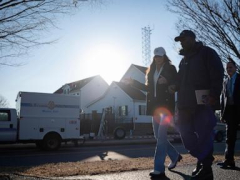ARLINGTON, Va. — Police boats combed the banks of the Potomac River on Friday morning, moving slowly and scanning the shoreline as part of the investigation into the midair collision that killed 67 people in the United States’ deadliest aviation disaster in almost a quarter century.
More than 40 bodies have been pulled from the river as the massive recovery effort continued, two law enforcement officials told The Associated Press on Friday. The officials were not authorized to discuss details of the investigation and spoke on condition of anonymity.
Crews worked under overcast skies Friday morning with rain expected throughout the day. Planes continued to take off and land at Reagan National, with airport operations gradually returning to normal after a slew of canceled and delayed flights following the crash.
Investigators have already recovered the cockpit voice recorder and flight data recorder of the American Airlines plane that collided with an Army helicopter as the plane was landing Wednesday night at Ronald Reagan National Airport next to Washington, D.C. Officials are scrutinizing a range of factors in what National Transportation Safety Board Chairwoman Jennifer Hommendy has called an “all-hands-on-deck event.”
All aboard the two aircraft were killed, with officials examining the actions of the military pilot as well as air traffic control after the helicopter apparently flew into the path of the American Airlines jet.
Air crash investigations normally take 12-18 months, and investigators told reporters Thursday they would not speculate on the cause.
Authorities were still looking for the helicopter’s black box recorder, Defense Secretary Pete Hegseth said Friday on Fox News Channel. Other factors in the crash, including the helicopter’s altitude and whether the crew was using its night vision goggles, are still under investigation, Hegseth said.
Although some of the airspace had already been restricted following the crash, the Federal Aviation Administration decided to indefinitely bar most helicopters from using the low-to-the-ground routes that run under or parallel to the airport’s flightpaths, an official told the AP on Friday. The official spoke on the condition of anonymity because they were not authorized to discuss the matter.
Military aircraft frequently conduct such flights in and around the nation’s capital for familiarization with routes they would fly in case of a major catastrophe or an attack on the U.S. that would require relocation of key officials from the capital region.
“You need to train as you fight, you need to rehearse in ways that would reflect a real world scenario,” Hegseth said. He stressed that it remained the Pentagon’s duty to also mitigate risks, while conducting such training. But he underscored U.S. forces need “to ensure, if unfortunately, there were a real world event where things needed to happen we could respond to it day or night.”
The plane carried 60 passengers and four crew members, and three soldiers were aboard the helicopter.
One air traffic controller was responsible for coordinating helicopter traffic and arriving and departing planes when the collision happened, according to a report by the FAA that was obtained by the AP.





